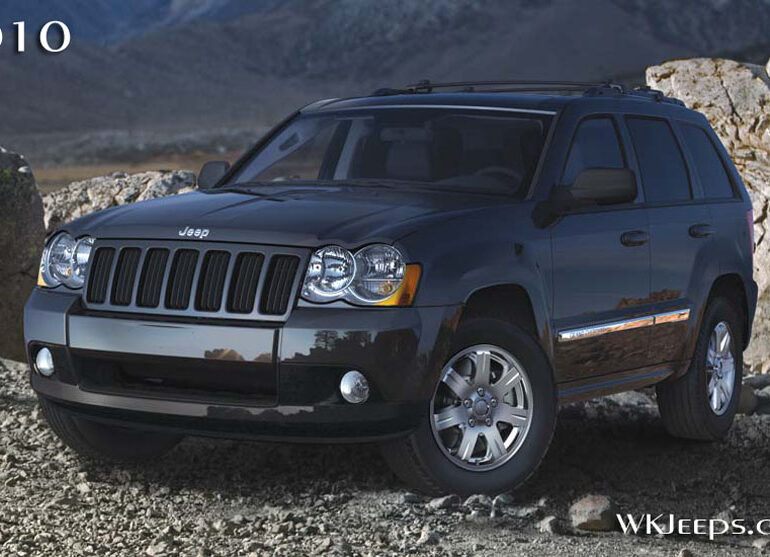Welcome to the JeepSpecs.com in-depth page on the WK Generation Jeep Grand Cherokee cooling system maintenance. Did we miss anything? Please get in touch with us and tell us about it!
CAUTION:
You or others can be badly burned by hot engine coolant/anti-freeze or steam from your radiator. If you see or hear steam coming from under the hood, don’t open the hood until the radiator has had time to cool. Never try to open a cooling system pressure cap when the radiator or coolant bottle is hot.
Engine Coolant Checks
Check engine coolant/anti-freeze protection every 12 months (before the onset of freezing weather, where applicable). If engine coolant/anti-freeze is dirty or rusty in appearance, the system should be drained, flushed and refilled with fresh engine coolant/anti-freeze.
Check the front of the radiator for any accumulation of bugs, leaves, etc. Clean the radiator by gently spraying water from a garden hose at the back of the core. Check the engine cooling system hoses for condition and tightness of connection. Inspect the entire system for leaks. Any hoses that show cuts or severe abrasion must be replaced.
Cooling System – Drain, Flush, And Refill
At the intervals shown in the appropriate Maintenance schedules, the system should be drained, flushed, and refilled.
If the solution is dirty and contains a considerable amount of sediment, clean and flush with reliable cooling system cleaner. Follow with a thorough rinsing to remove all deposits and chemicals.
Engine Coolant Disposal
Used ethylene glycol-based engine coolant/anti-freeze is a regulated substance requiring proper disposal. Check with your local authorities to determine the disposal rules for your community. Do not store ethylene glycolbased engine coolant/anti-freeze in open containers or allow it to remain in puddles on the ground. Prevent ingestion by animals and children. If ingested by a child, contact a physician immediately. Clean up any ground spills immediately.
Selection Of Engine Coolant
Use only the manufacturer’s recommended engine coolant/anti-freeze, refer to Recommended Fluids, Lubricants, and Genuine Parts for correct engine coolant/ anti-freeze type.
CAUTION!
Mixing of engine coolants other than the specified HOAT engine coolant/anti-freeze may result in decreased corrosion protection and engine damage. If a non-HOAT engine coolant/anti-freeze is introduced into the cooling system in an emergency, it should be replaced with the specified engine coolant/antifreeze as soon as possible.
Do not use plain water alone or alcohol base engine coolant/anti-freeze products. Do not use additional rust inhibitors or antirust products, as they may not be compatible with the engine coolant/anti-freeze and may plug the radiator.
This vehicle has not been designed for use with Propylene Glycol based engine coolant/anti-freeze. Use of Propylene Glycol base engine coolant/antifreeze is not recommended.
Adding Engine Coolant
When adding engine coolant/anti-freeze, a minimum solution of 50% recommended HOAT ethylene glycol engine coolant/anti-freeze in water should be used. Use higher concentrations (not to exceed 70%) if temperatures below -34°F (-37°C) are anticipated. Use only high purity water such as distilled or deionized water when mixing the water/engine coolant (antifreeze) solution. The use of lower quality water will reduce the amount of corrosion protection in the engine cooling system.
Please note that it is the owner’s responsibility to maintain the proper level of protection against freezing according to the temperatures occurring in the area where the vehicle is operated.
NOTE: Mixing engine coolant types will decrease the life of the engine coolant/anti-freeze and will require more frequent engine coolant/anti-freeze changes.
Cooling System Pressure Cap
The cap must be fully tightened to prevent loss of coolant, and to insure that coolant will return to the radiator from the coolant reserve tank. The cap should be inspected and cleaned if there is any accumulation of foreign material on the sealing surfaces.
WARNING!
The warning words DO NOT OPEN HOT on the cooling system pressure cap are a safety precaution. Never add engine coolant/anti-freeze when the engine is overheated. Do not loosen or remove the cap to cool an overheated engine. Heat causes pressure to build up in the cooling system. To prevent scalding or injury, do not remove the pressure cap while the system is hot or under pressure.
Engine Coolant Level
Check the engine coolant level at least once a month or more often in hot weather. Check the level when the engine is at normal operating temperature. Check the engine coolant level only in the coolant recovery bottle. The engine coolant level must be between the FULL and the ADD mark on the bottle. See your authorized dealer if the engine coolant level drops quickly.
Points To Remember
NOTE: When the vehicle is stopped after a few miles of operation, you may observe vapor coming from the front of the engine compartment. This is normally a result of moisture from rain, snow, or high humidity accumulating on the radiator and being vaporized when the thermostat opens, allowing hot coolant to enter the radiator.
If an examination of your engine compartment shows no evidence of radiator or hose leaks, the vehicle may be safely driven. The vapor will soon dissipate.
Do not overfill the coolant bottle.
Check engine coolant/anti-freeze freeze point in the system.
If frequent engine coolant/anti-freeze additions are required, or if the level in the recovery bottle does not drop when the engine cools, the cooling system should be pressure tested for leaks.
Maintain engine coolant/anti-freeze concentration at 50%, ethylene glycol engine coolant/anti-freeze (minimum) in water for proper corrosion protection of your engine that contains aluminum components.
Make sure that the radiator and coolant bottle hoses are not kinked or obstructed.
Do not change the thermostat for summer or winter operation. If replacement is ever necessary, install ONLY the correct type thermostat. Other designs may result in unsatisfactory cooling performance, poor gas mileage, and increased emissions.

